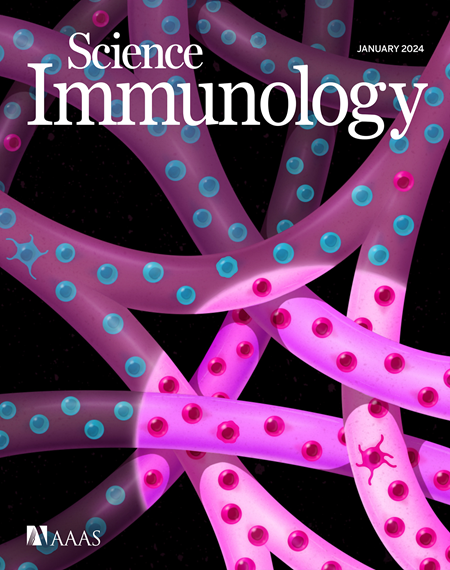lck共受体关联确保T细胞谱系保真度和最大化表位特异性TCR多样性
IF 17.6
1区 医学
Q1 IMMUNOLOGY
引用次数: 0
摘要
CD4/CD8共受体和LCK(一种Src家族酪氨酸激酶)之间的相互作用被认为可以增强T细胞在识别装载肽的主要组织相容性复合体(pmhc)时的活化。然而,这种相互作用如何影响抗原特异性T细胞的发育尚不清楚,正如它对naïve和免疫抗原特异性T细胞的影响一样。在表达突变的内源性LCK无法结合共受体的小鼠(LCK FREE小鼠)中,我们发现甲型流感病毒(IAV)衍生的pmhc特异性CD8和CD4 T细胞反应明显缩小了T细胞受体(TCR)库,倾向于高亲和力的TCR。这种狭窄是在T细胞发育过程中形成的,在病毒感染后加剧。LCK与共受体的分离也导致cd4 -宿命T细胞重定向到CD8谱系,在IAV感染后观察到pmhcii特异性细胞毒性CD8 T细胞扩增。因此,lck共受体关联对于确保T细胞谱系保真度和最大化抗原特异性T细胞库多样性至关重要。本文章由计算机程序翻译,如有差异,请以英文原文为准。
LCK–co-receptor association ensures T cell lineage fidelity and maximizes epitope-specific TCR diversity
The interaction between the CD4/CD8 co-receptors and LCK (an Src family tyrosine kinase) is thought to augment T cell activation upon recognition of peptide-loaded major histocompatibility complexes (pMHCs). How this interaction influences antigen-specific T cell development is unclear however, as is its impact on naïve and immune antigen-specific T cell repertoires. In mice expressing mutated endogenous LCK unable to bind co-receptors (LCK FREE mice), we show that influenza A virus (IAV)–derived pMHC-specific CD8 and CD4 T cell responses had a significantly narrowed T cell receptor (TCR) repertoire, favoring high-affinity TCRs. This narrowing was established during T cell development and was exacerbated after viral infection. The dissociation of LCK from co-receptors also resulted in the redirection of CD4-fated T cells to the CD8 lineage, with expanded pMHCII-specific cytotoxic CD8 T cells observed after IAV infection. Thus, LCK–co-receptor association is critical for ensuring T cell lineage fidelity and maximizing antigen-specific T cell repertoire diversity.
求助全文
通过发布文献求助,成功后即可免费获取论文全文。
去求助
来源期刊

Science Immunology
Immunology and Microbiology-Immunology
CiteScore
32.90
自引率
2.00%
发文量
183
期刊介绍:
Science Immunology is a peer-reviewed journal that publishes original research articles in the field of immunology. The journal encourages the submission of research findings from all areas of immunology, including studies on innate and adaptive immunity, immune cell development and differentiation, immunogenomics, systems immunology, structural immunology, antigen presentation, immunometabolism, and mucosal immunology. Additionally, the journal covers research on immune contributions to health and disease, such as host defense, inflammation, cancer immunology, autoimmunity, allergy, transplantation, and immunodeficiency. Science Immunology maintains the same high-quality standard as other journals in the Science family and aims to facilitate understanding of the immune system by showcasing innovative advances in immunology research from all organisms and model systems, including humans.
 求助内容:
求助内容: 应助结果提醒方式:
应助结果提醒方式:


